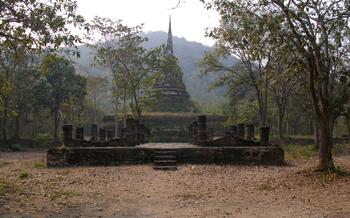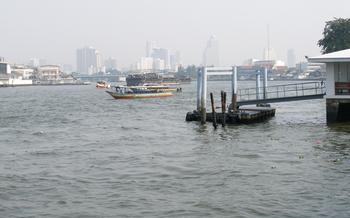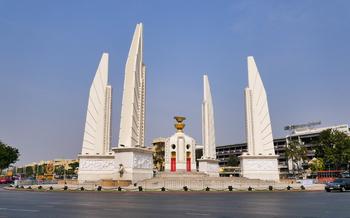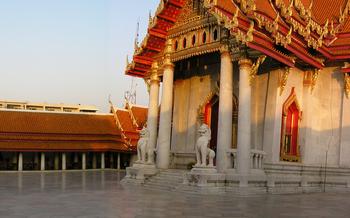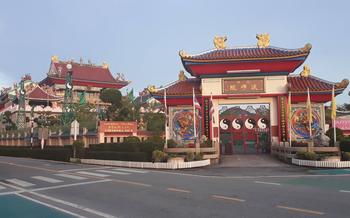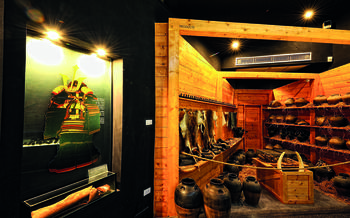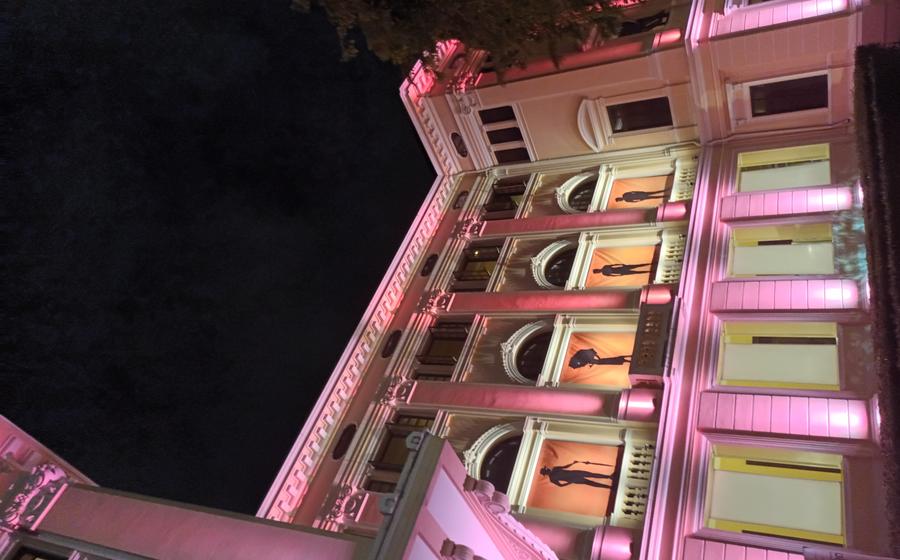
Museum of Siam
- Unveiling the Essence of Thai History
- Navigating the Museum's Exhibits
- Immerse Yourself in Thai Culture
- Understanding the Monarchy's Role
- Exploring Thai Art and Craftsmanship
- Learning about Thai Cuisine
- Understanding Thai Religion and Beliefs
- The Significance of Thai Temples and Shrines
- Interactive Experiences for Visitors
- Temporary Exhibitions and Special Events
- Museum Tours and Guided Visits:
- Accessibility and Facilities
- Visitor Tips and Etiquette
- Educational Resources and Publications
- Insider Tip:
Unveiling the Essence of Thai History
Nestled in the heart of Bangkok, the Museum of Siam stands as a testament to the rich and vibrant history of Thailand. Established in 2007, the museum occupies a significant place in the city's cultural landscape, inviting visitors to explore the Kingdom's fascinating past and delve into the roots of its unique identity.
The museum's strategic location on the banks of the Chao Phraya River, adjacent to the Grand Palace and Wat Pho, further emphasizes its importance. This proximity to other historic landmarks symbolizes the deep connection between the museum's exhibits and the broader narrative of Thailand's cultural heritage.
Architecturally, the Museum of Siam blends traditional Thai design elements with modern aesthetics. The museum's exterior features intricate carvings and motifs inspired by ancient Thai architecture, while the interior boasts spacious galleries and state-of-the-art facilities, creating a harmonious fusion of the past and the present.
As visitors step into the museum, they are greeted by a captivating display of artifacts, interactive exhibits, and multimedia presentations that provide historical context and insights into the diverse aspects of Thai history, culture, and traditions.
Navigating the Museum's Exhibits
The Museum of Siam offers a diverse range of exhibits and galleries that take visitors on a journey through Thailand's rich history and culture. Each exhibit is carefully curated to provide a comprehensive understanding of the nation's past and present.
The museum's permanent exhibits include the following:
History of Siam: This exhibit traces the origins of the Thai people and their migration to the Chao Phraya River Valley. It explores the establishment of the Ayutthaya Kingdom and its subsequent rise and fall.
Thai Art and Culture: This exhibit showcases the diverse artistic traditions of Thailand, from traditional dance and music to elaborate handicrafts. Visitors can admire intricate sculptures, colorful paintings, and beautiful textiles.
Thai Beliefs and Traditions: This exhibit delves into the religious and spiritual beliefs of the Thai people. It explores the role of Buddhism in Thai society and the significance of animism and ancestor worship.
Contemporary Thailand: This exhibit examines the challenges and opportunities facing modern-day Thailand. It explores the country's rapid economic development, its political transformation, and its role in the global community.
In addition to these permanent exhibits, the museum also hosts a variety of temporary exhibitions that focus on specific themes or topics related to Thai history and culture. These exhibitions often feature interactive displays, multimedia presentations, and special events.
Visitors can enhance their experience by taking advantage of the museum's audio guide, which provides detailed information about the exhibits in multiple languages. Guided tours are also available for those who prefer a more personalized experience.
Immerse Yourself in Thai Culture
The Museum of Siam is an immersive journey into the vibrant tapestry of Thai culture. As you wander through the exhibits, you'll discover the intricate customs, traditions, and art forms that have shaped this nation for centuries.
Traditional Thai costumes, with their vibrant colors and intricate designs, are showcased in the museum, providing a glimpse into the country's rich sartorial heritage. Visitors can also witness live performances of traditional Thai dance, which is characterized by its graceful movements and elaborate costumes.
The museum offers visitors the opportunity to participate in cultural activities, such as learning how to make traditional Thai crafts or trying on traditional Thai clothing. These hands-on experiences provide a deeper understanding of Thai culture and allow visitors to connect with the local people and their way of life.
Thai etiquette and social norms are also explored in the museum, providing visitors with insights into the polite and respectful behavior expected in Thai society. Learning about these customs helps visitors navigate social interactions in Thailand with ease and avoid any cultural faux pas.
Understanding the Monarchy's Role
The Museum of Siam provides an insightful journey into the intricate tapestry of the Thai monarchy, a cornerstone of the nation's history and culture. Through captivating exhibits, visitors can delve into the rich heritage and traditions that have shaped Thailand's royal lineage.
Exhibits dedicated to the monarchy showcase the opulent regalia, elaborate ceremonies, and significant milestones that have defined the kingdom's history. Visitors can learn about the profound reverence accorded to the monarchy, the sacred rituals associated with royal transitions, and the deep-seated connection between the royal family and the Thai people.
The museum also highlights the role of the monarchy in modern-day Thailand. Visitors gain insights into the constitutional monarchy system, the reigning monarch's responsibilities, and the monarchy's ongoing significance in shaping Thailand's national identity and unity.
By exploring these exhibits, visitors can gain a comprehensive understanding of the monarchy's enduring role in Thai society, its historical importance, and its continued relevance in the contemporary context.
Exploring Thai Art and Craftsmanship
The Museum of Siam is an artistic treasure trove, showcasing the rich craftsmanship and artistry that have shaped Thai culture for centuries. Visitors can explore a diverse collection of traditional Thai art forms, from delicate silk paintings to intricate wood carvings and ornate silverware. Each piece on display reflects the unique skills and techniques passed down through generations of Thai artisans.
The museum's exhibits highlight the different styles and materials used in Thai art. Visitors can learn about the significance of nielloware, a metalworking technique that combines silver and black enamel to create intricate designs. They can admire the delicate porcelain figurines known as Benjarong, which are hand-painted with vibrant colors and intricate patterns. The museum also showcases the beauty of traditional Thai textiles, including hand-woven silk and intricately embroidered fabrics.
Beyond the museum's walls, visitors can find a variety of opportunities to purchase authentic Thai crafts. The nearby Chatuchak Weekend Market is a popular destination, offering a vast selection of handmade goods from all over Thailand. Visitors can browse through stalls selling colorful ceramics, woven baskets, and unique jewelry pieces, all crafted with traditional techniques.
Exploring Thai art and craftsmanship is an integral part of understanding the cultural heritage of Thailand. The Museum of Siam provides visitors with a glimpse into the artistry and creativity that have shaped this vibrant nation, while the bustling markets offer a chance to bring a piece of Thai craftsmanship home.
Learning about Thai Cuisine
Food holds a central place in Thai culture, and the Museum of Siam offers a fascinating glimpse into the culinary traditions of this vibrant nation. Through interactive exhibits and displays, visitors can explore the diverse ingredients, cooking techniques, and regional specialties that make Thai cuisine so beloved worldwide.
One of the highlights of the museum's food-related exhibits is a replica of a traditional Thai kitchen, complete with authentic utensils and cooking equipment. Visitors can learn about the essential ingredients used in Thai cooking, such as rice, noodles, chilies, and coconut milk, and how they are combined to create the unique flavors that define Thai cuisine.
The museum also hosts cooking demonstrations and workshops, where visitors can learn to prepare classic Thai dishes under the guidance of experienced chefs. These hands-on experiences offer a deeper understanding of Thai culinary techniques and provide a memorable way to engage with Thai culture.
To fully experience the richness of Thai cuisine, visitors should venture outside the museum and sample the many street food stalls and restaurants that line the streets of Bangkok. From fiery curries and fragrant noodle soups to sweet desserts and tropical fruits, there is something to satisfy every palate.
Whether you're a food enthusiast, a curious traveler, or simply looking for a taste of authentic Thailand, the Museum of Siam offers a comprehensive and engaging journey into the world of Thai cuisine.
Understanding Thai Religion and Beliefs
Thai society is deeply rooted in Buddhism, with over 90% of the population identifying as Buddhist. The Museum of Siam provides visitors with an insightful glimpse into the kingdom's religious practices and beliefs.
The exhibits explore the history and development of Buddhism in Thailand, showcasing artifacts related to Buddhist ceremonies, rituals, and iconography. Visitors can learn about the lives of important monks and teachers, as well as the role of Buddhism in shaping Thai culture and society.
The museum also offers opportunities for visitors to experience Buddhist practices firsthand. Meditation sessions and chanting ceremonies are regularly held, allowing visitors to immerse themselves in the tranquility and spirituality of this ancient religion.
The Significance of Thai Temples and Shrines
Buddhist temples, known as wats, play a crucial role in Thai society, serving as centers of religious devotion, community gathering, and education. The Museum of Siam features a section dedicated to the architecture, design, and symbolism of Thai temples.
Visitors can learn about the different types of temples, their unique features, and the rituals and ceremonies that take place within them. The museum also showcases replicas of famous Thai temples, allowing visitors to appreciate their intricate details and grandeur.
Exploring Thai religion and beliefs at the Museum of Siam is a profound experience that provides visitors with a deeper understanding of the spiritual and cultural foundations of Thailand.
Interactive Experiences for Visitors
The Museum of Siam offers a range of interactive exhibits and activities that enhance the visitor experience and make learning about Thai history and culture more engaging. Interactive touchscreens, multimedia displays, and hands-on activities bring the exhibits to life, allowing visitors to explore and interact with the content in a meaningful way.
For children and families, the museum has a dedicated Discovery Zone where they can participate in educational games, puzzles, and crafts related to Thai culture. These activities help children learn about Thailand's rich heritage in a fun and interactive way, fostering a love for learning and appreciation for Thai history.
The museum also offers educational programs and workshops for visitors of all ages. These programs cover a variety of topics, from traditional Thai dance and music to cooking classes and craft workshops. Visitors can immerse themselves in Thai culture and learn new skills while interacting with experts and fellow participants.
Technology plays a significant role in enhancing the visitor experience at the Museum of Siam. Interactive maps and timelines allow visitors to explore the history of Thailand and its regions in a visually engaging way. Augmented reality and virtual reality experiences transport visitors to different historical periods and locations, providing a truly immersive and unforgettable experience.
Temporary Exhibitions and Special Events
The Museum of Siam is an ever-evolving and dynamic cultural institution that consistently presents a diverse range of temporary exhibitions and special events throughout the year. These exhibitions delve into specific themes or aspects of Thai history, culture, and traditions, offering visitors a deeper insight into the country's rich heritage.
Temporary exhibitions often focus on specific periods, individuals, or cultural practices, showcasing rare artifacts, interactive displays, and multimedia presentations. They provide an opportunity for visitors to explore various facets of Thai history and culture that may not be covered in the permanent exhibits.
Special events, such as workshops, lectures, and cultural performances, are regularly organized to complement the temporary exhibitions and enhance the visitor experience. These events offer visitors the chance to engage with experts, participate in hands-on activities, and immerse themselves in Thai culture through traditional music, dance, and crafts.
To stay updated on the latest exhibitions and events, visitors are encouraged to check the museum's website or social media platforms. The museum also offers a monthly newsletter that provides information about upcoming events, educational programs, and special promotions.
Museum Tours and Guided Visits:
The Museum of Siam offers a variety of tours and guided visits to enhance the visitor experience. Knowledgeable and experienced guides lead these tours, providing in-depth insights into the museum's exhibits and Thai history and culture.
Guided tours are available in various languages, including English, Thai, and Mandarin. Visitors can choose from general admission tours that provide an overview of the museum's highlights to thematic tours that focus on specific aspects of Thai history and culture.
For a more personalized experience, visitors can book private tours tailored to their interests and requirements. These tours allow for a more in-depth exploration of the museum's collection and the opportunity to ask questions directly to the guide.
Group tours are also available for schools, organizations, and corporate groups. These tours can be customized to meet the specific needs and interests of the group.
To book a tour or make a reservation, visitors can contact the museum's information desk or visit the museum's website. Advance booking is recommended, especially for group tours and during peak tourist seasons.
Accessibility and Facilities
The Museum of Siam is committed to providing an accessible and enjoyable experience for all visitors. Wheelchair ramps and elevators are available throughout the museum, ensuring that visitors with disabilities can easily navigate the exhibits. Restrooms, cafes, and a gift shop are also conveniently located within the museum, offering a comfortable and convenient experience for all. The museum also provides a range of amenities and services to enhance the visitor experience, including multilingual audio guides, lockers for storing personal belongings, and a cloakroom for storing coats and umbrellas. For those arriving by car, ample parking is available on-site, and the museum is also easily accessible by public transportation.
Visitor Tips and Etiquette
Arrive Early: - The museum opens at 10 am; to avoid the midday crowds, plan your visit for the morning hours.
Dress Appropriately: - While there is no strict dress code, respectful attire is encouraged; cover your shoulders and knees, especially if visiting temples or sacred areas.
Mind Your Manners: - Be mindful of your behavior; loud talking or disruptive actions are discouraged; silence your phone and refrain from using flash photography.
Photography and Videography: - Photography is allowed, but tripods and selfie sticks are prohibited; for videography or professional photography, inquire at the information desk.
Respect the Artifacts: - Refrain from touching or leaning on exhibits; use provided hand sanitizers to prevent damage to delicate artifacts.
Explore at Your Pace: - The museum offers a self-guided tour; however, a guided tour is recommended for a deeper understanding of the exhibits.
Enjoy the Museum Cafe: - Take a break at the museum's cafe, which offers a variety of Thai and international dishes, allowing you to refuel while immersing yourself further in Thai culture.
Educational Resources and Publications
The Museum of Siam is an educational hub that offers a wealth of resources to visitors eager to deepen their understanding of Thai culture and history. Visitors can purchase comprehensive books, brochures, and souvenirs that delve into various aspects of Thai heritage, including art, crafts, cuisine, and religious practices. These publications are meticulously researched and written by experts in their respective fields, ensuring accuracy and depth of information. Furthermore, the museum collaborates with scholars, artists, and cultural organizations to produce high-quality exhibitions and publications that contribute to the preservation and promotion of Thai culture. By supporting the museum's educational initiatives, visitors can actively contribute to the perpetuation of Thailand's rich cultural legacy.
Insider Tip:
Discover the Secret Passageway and Hidden Room:
Unveil a hidden gem within the Museum of Siam—a secret passageway and a concealed room that few visitors know about. As you wander through the museum's corridors, keep an eye out for a discreet door that blends seamlessly with the walls. Behind this unassuming entrance lies a hidden chamber filled with rare artifacts and intriguing stories. Immerse yourself in the mystery of Thailand's past as you uncover the secrets of this hidden room.
